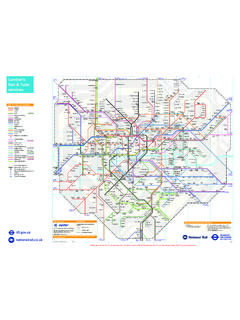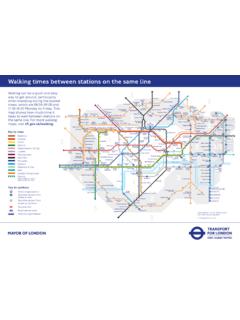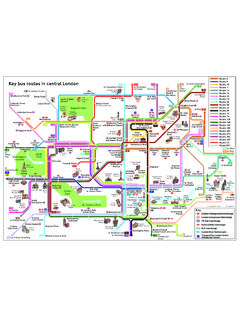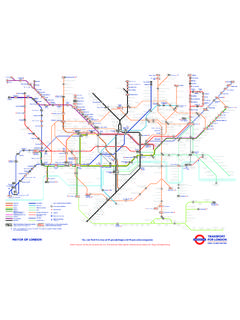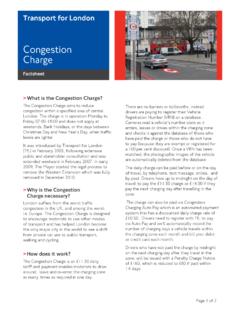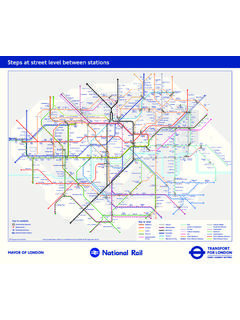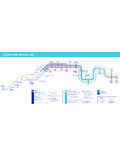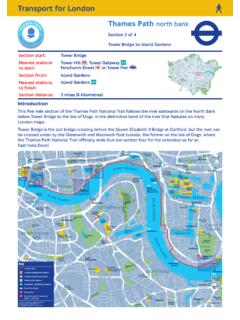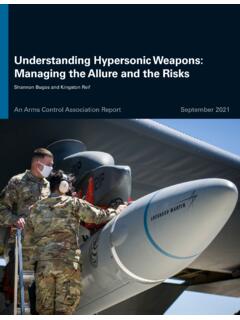Transcription of Accessible bus stop design guidance - Transport for London
1 ACCESSIBLEBUS STOP design GUIDANCEREVISED EDITION 2017 MAYOR OF LONDON02 Accessible Bus Stop design GuidanceContentsThe Accessible Bus Stop design guidance sets out requirements and guidance for the design of Accessible bus stop environments. It should be used by those who shape the environment through planning and street design as well as engineers designing bus-specific document forms one part of Transport for London s Streetscape Toolkit, and should be read in conjunction with other TfL guidance documents: Streetscape guidance London Pedestrian design guidance London Cycling design Standards Kerbside Loading guidance Station Public Realm Urban design GuidancePublished by Transport for London .
2 042 Accessible bus stop waiting stop stop profiles and sources and Accessible Bus Stop design GuidanceFiguresFiguresFigure 1 Street Types for 07 Figure 2 Features of the bus stop 3 Passenger groups benefiting from low-floor 4 Bus stop layout 5 Relationship between buses and 6 Considerations for bus stop 7 Bus arrival 8 Centre of path 9 Back to kerb 10 Back of path 21 Figure 11 Boarding and alighting 12 Kerbside approach with parking on approach and 13 Exit side of pedestrian 14 Exit side of 15 Full-width 16 Alternative full-width boarder 17 Multiple bus full-width 18 Half-width 19 Amended bus 20 Filled-in bus bay with 21 Half-filled bus 22 Mandatory cycle lane at bus 23 Indicative bus stop bypass Accessible Bus Stop design GuidanceIntroductionThis chapter provides an introduction to the guidance and a summary of the key requirements to achieve an Accessible bus stop.
3 1. IntroductionBUSSTOPBUSSTOP05 Accessible Bus Stop design Guidance1. INTRODUCTIONE very day in London million journeys are made by customers with disabilities, 700,000 journeys are made by people aged over 75, nearly five million journeys are made by passengers carrying heavy luggage and million by people with small children. Ensuring that the London bus network continues to be Accessible for all Londoners, is critical for London s future economic prosperity and social cohesion. There are many different user groups who have different needs with regard to bus stop design . Specific user groups that need special consideration include those customers that use a wheelchair, have limited mobility, are blind or visually impaired, are hearing impaired, have learning difficulties and the elderly.
4 It is also important that designers consider these different user needs such as those who use wheelchairs, crutches, walking sticks, canes, guide dogs, mobility scooters, shopping trolleys, and buggies accessing bus guide updates the Accessible Bus Stop guidance note BP1/06 published in January 2006 and its predecessor documents. These updated guidelines have been developed in the context of the Equality Act 2010, the Mayor s Transport Strategy and the Accessibility Implementation Plan. This intention of this guidance is to help encourage all those involved in the design , construction and operation of London s roads to consider the different accessibility needs of Londoners who use the TfL bus network.
5 The importance of an Accessible bus service will increase as the number of older and disabled Londoners is projected to rise significantly. This document updates the original accessibility guidance to ensure it is both relevant and reflects changes in policy. Key additions include:Introduction Revised criteria for an Accessible bus stop New chapters on interaction of bus stops with other street facilities ( cycle facilities and other considerations )Key omissions include: Removal of references to articulated buses and particular kerb types that are not specified for use by TfL06 Accessible Bus Stop design GuidanceIntroductionAccessible bus stopsThis guidance , aims to provide all those involved in the construction of bus stops with design guidance that ensures bus stops are Accessible to all, particularly disabled passengers.
6 This guidance will also assist highway authorities in the development of practical and affordable measures to improve accessibility at bus stops that are compatible with the particular characteristics of low-floor buses deployed on London s road introduction of low-floor buses fitted with ramps for wheelchair access throughout London , has led to a requirement for appropriate kerbside access at bus stops. Unless all stops along a bus route are equally Accessible , passengers may be unable to board or alight a bus at their desired location and the potential benefits from low-floor buses will be reduced. This hinders the public Transport network being fully Equalities Act (2010) places a duty on both public Transport operators and highway authorities to provide reasonable adjustments so that disabled passengers are not disadvantaged.
7 Providing access between a low-floor bus (fitted with ramps) and the footway, is crucial to fulfilling these duties. It is also important to consider the needs of other disabled groups such as blind or cognitive impaired bus passengers, as well as those carrying heavy luggage and pushchairs. From an operational perspective, a well designed bus stop can provide significant benefits. Bus stop design and location is recognised as a key element in the drive to improve the quality of bus services for all users. It is important to view the bus stop as an interchange, rather than simply a location along a bus route where buses stop, comprising only a post with a flag and a cage laid on the road surface.
8 Bus passengers are also pedestrians at each end of the bus trip and all elements of their journey should be considered including the convenience and comfort of the waiting Types for London frameworkThe Street Types for London framework has been developed in recent years in collaboration with London s boroughs. It takes account of local and network priorities and aims to help the consistent allocation of road space across London . The aim is to ensure consistency in approach in considering the operation and function of different streets. For all Street Types Accessible bus stop facilities should be provided, however Street Types may influence the different levels of service and capacity will be required at bus stops.
9 A designer can highlight where specific schemes have been successful in encouraging better behaviour or more efficient use of space and assess whether a similar approach may be sensible for a location with a matching Street Types. This translation of Street Types into a specific response should help identify where people should expect to find similar types of infrastructure or levels of service across London . Ultimately, the Street Types framework provides a unified view of London s roads. Within this framework, the individual design elements which cumulatively influence the bus stop environment can be considered for each location, as illustrated in figure 1.
10 The Street Types framework indicates how the relative significance of movement and place influences the suitability of a particular design and expectations for the level of provision required. As such, Street Types provide an overarching context to discuss the suitability of applying the design tools defined within this Accessible Bus Stop design GuidanceIntroductionPlaceMovementStrateg ic significanceStrategic significanceLocal significanceLocal significanceeg Core roadM3P1M3P2M3P3M2P1M2P2M2P3M1P1M1P2M1P3 eg High roadeg High streeteg City streeteg Town squareeg City hubeg Connectoreg Local streeteg City placeFigure 1.
